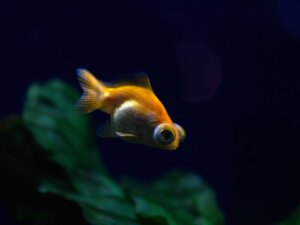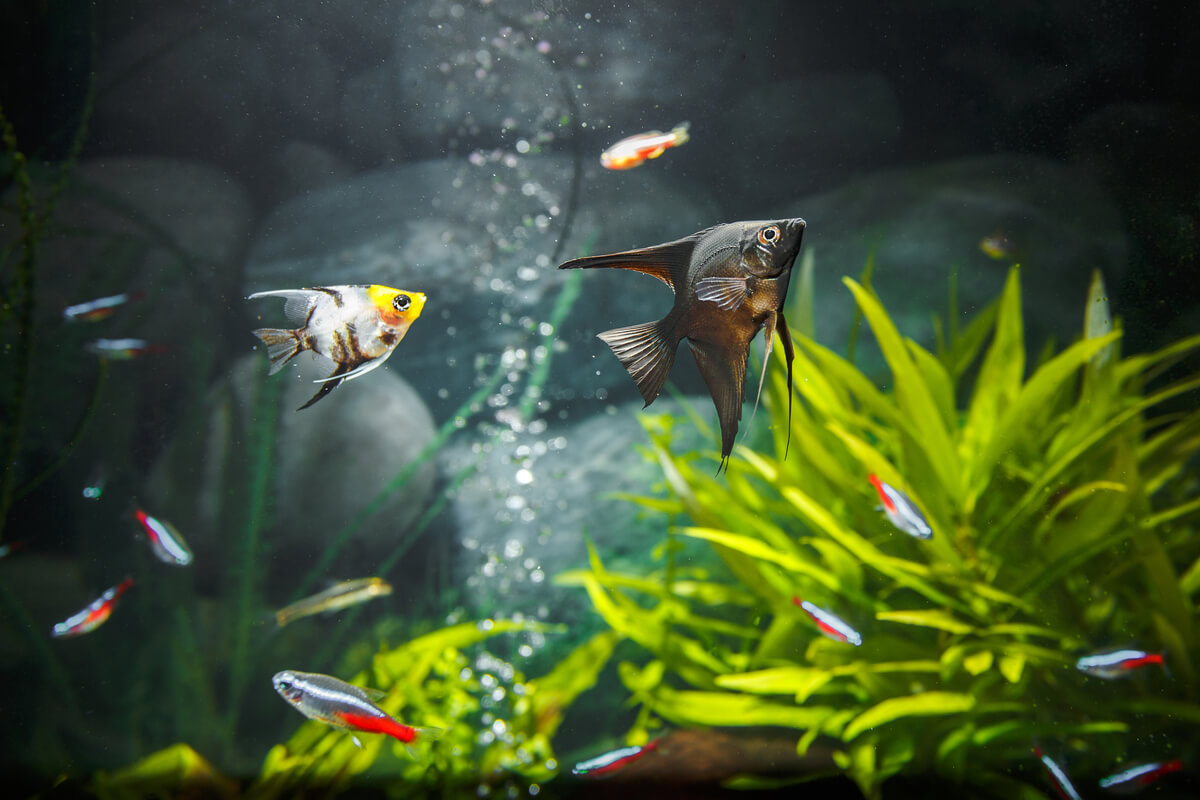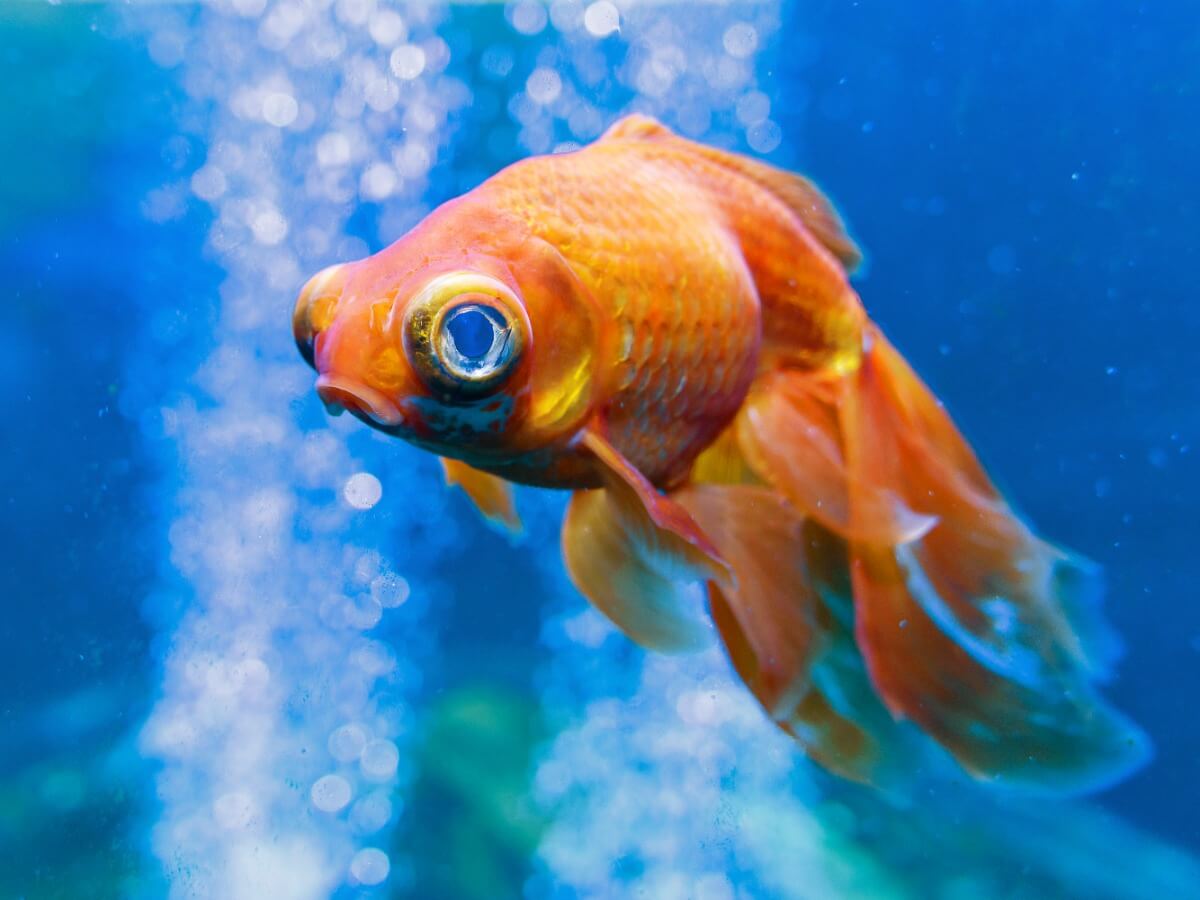Popeye Disease in Fish: Everything You Need to Know


Written and verified by the biologist Samuel Sanchez
Eye diseases are normal in fish tanks. Dirty water, a lack of oxygenation, poor water recycling, or the presence of sharp objects in the aquarium can be a cause of damage to the inhabitant’s eyes. Popeye disease, medically known as exophthalmos, is one of the most common.
However, it should be noted that some fish present this characteristic as a non-pathological trait. If you want to know everything about this condition, read on.
What is popeye disease in fish?
Vision is a very important sense for many species of fish. The eyes of these vertebrates are similar to those of terrestrial ones, but they differ from the rest in that they have spherical lenses — and not convex ones, as is the case of humans. They also have rods and cones, cells specialized in photoreception, and they often see in color.
The term exophthalmos refers to the propulsion of the eyeball from the orbital cavity that contains it. This condition can occur in any vertebrate that large-sized eyes in their skull cavity, such as dogs, cats and humans. In our species, this usually occurs as a result of Graves-Basedow disease, traumatic lesions, tumors, and abscesses.
On the other hand, fish can also have exophthalmos, but this can be pathological or caused by humans. Next up, we’ll explore the reason for this unusual ocular propulsion.

Symptoms
As the name itself indicates, the main symptom of exophthalmos in fish is that the animal has a bulging, swollen, and strange-looking eye. This is due to excess fluid in the eye sockets, which exerts pressure and forces the eye to protrude more than normal. In this state, simultaneous bacterial infections are common.
In addition, it’s very likely that the fish will also have a whitish color in the eye. This sign is a manifestation of the damage caused to the cornea, by excess pressure in the eye, mechanical stress, and possible pathogens in the eye tissue. If the cause is a direct injury, the area may also appear bloody.
Causes of popeye disease in fish
It’s very important to differentiate popeye disease into its two variants: unilateral and bilateral. Next up, we’ll explore the particularities of each one of them.
Unilateral exophthalmos
If only one of the two eyes is damaged, it’s most likely that the fish has been injured by something in the aquarium. The local swelling and the wound will cause the popeye disease, which will surely also appear with sporadic bleeding.
In these cases, the best thing you can do is remove any unnatural ornaments from the aquarium, either temporarily or permanently. You should also observe if the fish in your tank are compatible, as specimens of another species may be attacking the patient.
Bilateral exophthalmos
Bilateral exophthalmos usually occurs due to poor levels in the aquarium. In a normal situation, fish are kept in perfect balance with the environment, as they lose and absorb fluids in order to keep their internal environment balanced. This set of processes is known as homeostasis.
Unfortunately, if the animal’s kidneys, liver, or gills aren’t working properly, fluids may build up in the animal’s body. This results in excess fluid in the eye sockets and, therefore, exophthalmos in both eyes at the same time.
Treatment
As indicated by specialized portals in fish care, tackling popeye disease isn’t easy, as it’s multifactorial pathology. The first step will always be to measure the aquarium levels – pH, temperature, ammonia. If they aren’t within the normal limits, the entire aquarium will have to be cleaned and a partial water change must be carried out.
If the damage to the cornea isn’t too severe, then this should be enough for the swelling to begin to subside. During the healing process, some owners also choose to add Epsom salts in small doses to aquarium water. These can help reduce inflammation and prevent the growth of pathogens, as studies indicate.
Other owners also use broad spectrum aquarium antibiotics. This could prevent the area from becoming inflamed.

How can you prevent the disease?
Preventing exophthalmos is simple: just measure the aquarium levels every week and carry out a 20% water change every 7 days. If the bottoms are kept clean and the cycling is adequate, a healthy fish shouldn’t develop this pathology. Also, remember that it’s much better to not have pointed objects as decorations in the tank.
On the other hand, it’s necessary to emphasize that some fish —such as the telescope-type goldfish— have congenital exophthalmos, which has been selected at a genetic level for aesthetic purposes. In these cases, the protrusion of the eyes is considered normal and is permanent.
Eye diseases are normal in fish tanks. Dirty water, a lack of oxygenation, poor water recycling, or the presence of sharp objects in the aquarium can be a cause of damage to the inhabitant’s eyes. Popeye disease, medically known as exophthalmos, is one of the most common.
However, it should be noted that some fish present this characteristic as a non-pathological trait. If you want to know everything about this condition, read on.
What is popeye disease in fish?
Vision is a very important sense for many species of fish. The eyes of these vertebrates are similar to those of terrestrial ones, but they differ from the rest in that they have spherical lenses — and not convex ones, as is the case of humans. They also have rods and cones, cells specialized in photoreception, and they often see in color.
The term exophthalmos refers to the propulsion of the eyeball from the orbital cavity that contains it. This condition can occur in any vertebrate that large-sized eyes in their skull cavity, such as dogs, cats and humans. In our species, this usually occurs as a result of Graves-Basedow disease, traumatic lesions, tumors, and abscesses.
On the other hand, fish can also have exophthalmos, but this can be pathological or caused by humans. Next up, we’ll explore the reason for this unusual ocular propulsion.

Symptoms
As the name itself indicates, the main symptom of exophthalmos in fish is that the animal has a bulging, swollen, and strange-looking eye. This is due to excess fluid in the eye sockets, which exerts pressure and forces the eye to protrude more than normal. In this state, simultaneous bacterial infections are common.
In addition, it’s very likely that the fish will also have a whitish color in the eye. This sign is a manifestation of the damage caused to the cornea, by excess pressure in the eye, mechanical stress, and possible pathogens in the eye tissue. If the cause is a direct injury, the area may also appear bloody.
Causes of popeye disease in fish
It’s very important to differentiate popeye disease into its two variants: unilateral and bilateral. Next up, we’ll explore the particularities of each one of them.
Unilateral exophthalmos
If only one of the two eyes is damaged, it’s most likely that the fish has been injured by something in the aquarium. The local swelling and the wound will cause the popeye disease, which will surely also appear with sporadic bleeding.
In these cases, the best thing you can do is remove any unnatural ornaments from the aquarium, either temporarily or permanently. You should also observe if the fish in your tank are compatible, as specimens of another species may be attacking the patient.
Bilateral exophthalmos
Bilateral exophthalmos usually occurs due to poor levels in the aquarium. In a normal situation, fish are kept in perfect balance with the environment, as they lose and absorb fluids in order to keep their internal environment balanced. This set of processes is known as homeostasis.
Unfortunately, if the animal’s kidneys, liver, or gills aren’t working properly, fluids may build up in the animal’s body. This results in excess fluid in the eye sockets and, therefore, exophthalmos in both eyes at the same time.
Treatment
As indicated by specialized portals in fish care, tackling popeye disease isn’t easy, as it’s multifactorial pathology. The first step will always be to measure the aquarium levels – pH, temperature, ammonia. If they aren’t within the normal limits, the entire aquarium will have to be cleaned and a partial water change must be carried out.
If the damage to the cornea isn’t too severe, then this should be enough for the swelling to begin to subside. During the healing process, some owners also choose to add Epsom salts in small doses to aquarium water. These can help reduce inflammation and prevent the growth of pathogens, as studies indicate.
Other owners also use broad spectrum aquarium antibiotics. This could prevent the area from becoming inflamed.

How can you prevent the disease?
Preventing exophthalmos is simple: just measure the aquarium levels every week and carry out a 20% water change every 7 days. If the bottoms are kept clean and the cycling is adequate, a healthy fish shouldn’t develop this pathology. Also, remember that it’s much better to not have pointed objects as decorations in the tank.
On the other hand, it’s necessary to emphasize that some fish —such as the telescope-type goldfish— have congenital exophthalmos, which has been selected at a genetic level for aesthetic purposes. In these cases, the protrusion of the eyes is considered normal and is permanent.
All cited sources were thoroughly reviewed by our team to ensure their quality, reliability, currency, and validity. The bibliography of this article was considered reliable and of academic or scientific accuracy.
- Stephens, F. J., Cleary, J. J., Jenkins, G., Jones, B., Raidal, S. R., & Thomas, J. B. (2001). Pathogenesis and epidemiology of spontaneous exophthalmos in the West Australian dhufish, Glaucosoma hebraicum Richardson. Journal of Fish Diseases, 24(9), 515-522.
- Biology, NCEA subject resources. Recogido a 10 de junio en https://www.nzqa.govt.nz/assets/qualifications-and-standards/qualifications/ncea/NCEA-subject-resources/Biology/91604-A/91604-EXP-Student2-001.pdf
- St-Hilaire, S., Price, D., Taylor, S., & Groman, D. (2015). Treatment of diplomonad intestinal parasites with magnesium sulphate at a commercial rainbow trout (Oncorhynchus mykiss) facility. The Canadian Veterinary Journal, 56(8), 876.
- CAÑADEL, J. M., & Barraquer, J. (1959). Enhancing effect of corticotrophin on thyrotrophin produced exophthalmos in fish. Endocrinology, 64(6), 1017-1022.
- Matty, A. J., Menzel, D., & Bardach, J. E. (1958). The production of exophthalmos by androgens in two species of teleost fish. Journal of Endocrinology, 17(3), 314-NP.
This text is provided for informational purposes only and does not replace consultation with a professional. If in doubt, consult your specialist.








